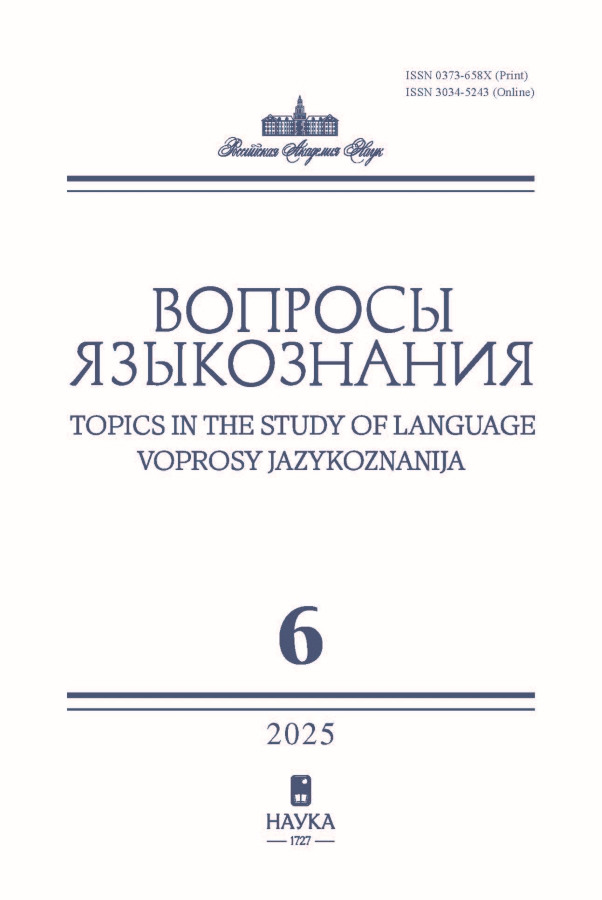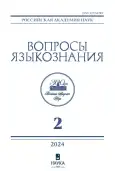No 2 (2024)
Articles
Russian National Corpus 2.0: New opportunities and development prospects
Abstract
The paper provides an overview of the results of the fundamental reconstruction and modernization project of the National Corpus of the Russian Language platform, carried out from 2020 to 2023. The focus of the paper is on the new opportunities that are opening up for linguists and a wider audience. This includes improving the representativeness of existing corpora, creating new corpora, new annotation obtained through the application of neural network models, and new interface solutions. Three notable new components are examined in more detail: a resource-related one, which is the new Social Networks corpus, a search-related one, which is the Panchronic corpus that combines searches across corpora from different periods, and an analytical one, which is the functional complex of statistics and data visualization.
 7-34
7-34


Asymmetry in Russian metalinguistic comparatives: corpus and experimental evidence
Abstract
The paper reports a corpus and experimental study of three types of Russian asymmetric metalinguistic comparatives (lučše, skoree, and bol’še meta-comparatives), two parts of which belong to different syntactic categories and/or have different morphological forms. We discuss their morphological and syntactic properties and uncover diversity among their types and various grammatical patterns that they allow. From a morphological point of view, infinitives in meta-comparatives tend to be imperfective, and finite verbs in the subjunctive and indicative mood are generally perfective. From a syntactic point of view, asymmetric meta-comparatives are either bi-clausal, bi-phrasal, or mixed (clausal-phrasal). The bi-phrasal variety shows functional homogeneity. Lučše meta-comparatives are more frequent in the corpus and are evaluated as more grammatical than skoree meta-comparatives. Furthermore, the asymmetric pattern ‘noun phrase + infinitive clause’ is evaluated as more grammatical than the pattern ‘finite clause + infinitive сlause’ for lučše meta-comparatives, while there is no such contrast between these patterns for skoree meta-comparatives. Our study sheds light on the grammatical portrait of Russian meta-comparatives as well as on the use and evaluation of asymmetric meta-comparatives in a natural language in general and thus contributes to the discussion of grammatical asymmetry in parallel syntactic structures, such as comparative and coordinated structures, among others.
 35-51
35-51


Skažem tak: Discourse markers originating from verbs of speech in Russian
Abstract
Based on data from the Russian National Corpus, first and foremost, from its multimedia corpus, we address two members of the family of discourse markers developed from the finite form of the verb of speech skažem (the first person plural present tense form of the verb ‘say’): isolated skažem and its combinations with an adverb or a pronominal adverb such as skažem prjamo ‘let’s put it bluntly’, skažem tak ‘let’s put it this way’, etc. We show that these markers demonstrate a typical pragmaticalization trajectory: unlike the original speech verb, they do not refer to a speech event, their main function is to express a fuzzy nomination, or hedging, i.e., these markers are used when the speaker disclaims responsibility for the possible inaccuracy of the propositional content or of the nomination used in relation to the fixed propositional content. We demonstrate the main shifts in the distribution of these markers, which occur due to the fact that they fall out of the rigid clausal structure and acquire the status of an operator which scopes over discourse segments of various (potentially any) length. We study the main prosodic properties of these markers instrumentally and perceptually and, in addition, discuss the use of markers of this family together with other means of signaling that the speaker needs additional efforts in choosing an adequate expression. These can be other lexical markers of fuzzy nomination, lexical and prosodic indicators of an open list, self-corrections, signals of hesitation (filled pauses, non-phonological lengthening of sounds), etc. The results obtained convincingly show: (1) that even within the same family of markers, the shift from a unit with propositional meaning to a discourse marker can follow different trajectories and lead to larger or smaller shifts in meaning and form; and (2) that the study of discourse markers that uses data on prosody and such specific phenomena of oral discourse as speech disfluencies makes it possible to get more comprehensive lexicographic portraits of single units and their families.
 52-82
52-82


The alternation of stem-internal a and o and pragmatic mechanisms of alternant distribution
Abstract
The article considers the alternation of letters a and o in the stem, missing in school and academic grammars, for example, shpargalka — shpora, boshka — boshki, simpatichnyj — simpotnyj, platit’ — plotit, nalit’ — nolito. We attempt to combine a number of heterogeneous (including unique) phenomena within the framework of a special alternation, and more specifically, the transition from a to o in an uncodified area of the language: in professional and youth jargons, popular language, emphatically colloquial speech. Thus, one can speak of relatively regular alternations of a and o at the junction of literary and non-literary language. The letter o conveys the phoneme [o], which appears under stress in not quite normative or informal word forms and words (colloquial, slang, etc.), that is, it emphasizes this informality of a word and often also its expressiveness.
 83-92
83-92


Defining pronominal series: demonstratives in West Circassian
Abstract
We discuss the concept of “pronominal series” and some principles that can be used for distinguishing pronominal series from similar phenomena. These principles are further applied to demonstratives in West Circassian (a polysynthetic language of the West Caucasian family) as represented in a large corpus including texts of various genres. We show that West Circassian displays at least eleven series of demonstratives but also make additional observations on how the principles defining pronominal series can be used in complex cases.
 93-121
93-121


Chukchi sonorant consonants in a typological perspective
Abstract
The article focuses on the sonorant consonants of the Chukchi language. Particular attention is paid to the consonants that show considerable phonetic variation: approximants (w, j and ɰ) and r. This variation is described in terms of acoustics and articulation, typology, history and dialectology of the Chukchi-Koryak languages, sociolinguistics and the influence of Russian. We use several approaches to link facts about the Chukchi language and explain some realisations of sonorants, as well as draw attention to cross-linguistic comparisons of approximants and rhotics. The study uses field recordings in the Amguema dialect of Chukchi.
 122-142
122-142


Surveys
“Language and body semiotics”. Grigory E. Kreidlin’s research on embodied semiotics
Abstract
The interaction between the body and the environment through non-verbal signs and the assignment of linguistic designations to these signs determines the transition from mere existence to the semiotic level. One of the basic principles of this approach is the following: the body as a tool in interaction with the environment and other subjects serves as a basis for evaluating all contexts and events primarily as favorable (for the existence and development of the body), unfavorable and neutral, as well as for determining the importance of individual events. In this way, the body becomes the source of the meanings inherent in signs. The body as a source of symbolic meanings has been considered in a wide range of fields, from psychoanalysis, philosophy, and art theory to studies in anthropology and cognitive science. The knowledge accumulated at the present stage allows us to study in more detail how body movements and, in general, the presence of the body and its parts in the communicative space are embedded in symbolic communication. The two-volume “Language and semiotics of the body”, written by a team of authors led by G. E. Kreidlin (2020), considers movements, body parts and their linguistic designations as a coherent and consistent sign system, which corresponds to the approach adopted within embodied semiotics, in which communicative events acquire their meaning based on the experience of their existence in the surrounding world and bodily interaction with it. This article considers the text of the collective monograph “Language and semiotics of the body” and modern approaches to the study of the symbolic representation of the body language as a culturally specific phenomenon. Although G. E. Kreidlin himself speaks of his field as non-verbal semiotics or multimodal linguistics, the publication of the book “Language and Semiotics of the Body” can be said to mark a significant contribution to the representation of embodied semiotics in the Russian-speaking linguistic space.
 143-158
143-158


Reviews
[Review of:] L. Johanson. Code Copying. The strength of languages in take-over and carry-over roles. Leiden: Brill, 2023. xvi + 149 p. (Brill Studies in Language, Cognition and Culture 38.) ISBN: 978-90-04-54843-5.
 159-164
159-164












